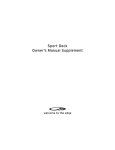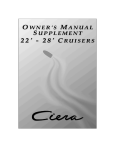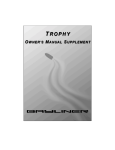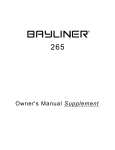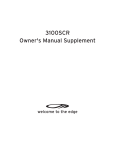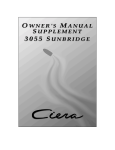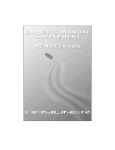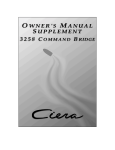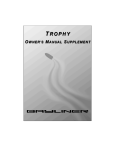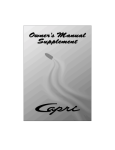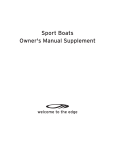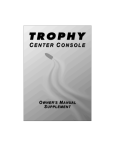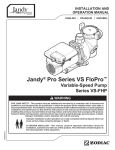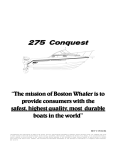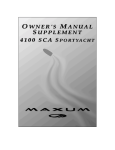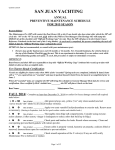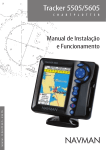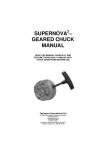Download Bayliner 2359 DXILX Owner`s manual
Transcript
The information in this Owner’s Manual Supplement relates to 2000 & 2001 2302 DX/LX, 2352 DX/LX 2359, DX/LX Bayliner Trophy Fishing Boats. Hull Identification Number___________________________________________ Engine Serial Number _______________________________________________ Hull Identification Number: The Hull Identification Number (HIN) is located on the starboard side of the transom. Record the HIN and the engine serial number in the space provided above. Refer to the HIN for any correspondence or orders. HULL IDENTIFICATION NUMBER HIN LOCATION (TYPICAL) TRANSOM © 2000 Bayliner Technical Publications. All rights reserved. No part of this publication may be reproduced, stored in any retrieval system, or transmitted in any form by any means, electronic, mechanical, photocopying, recording or otherwise, without prior written permission of Bayliner. Printed in the United States of America. Changes The material in this document is for information only and is subject to change without notice. While reasonable efforts have been made in the preparation of this document to assure its accuracy, Bayliner assumes no liability resulting from errors or omissions in this document, or from the use of information contained herein. Bayliner reserves the right to make changes in the product design, specifications, and equipment at any time without notice or obligation. Illustrations and/or photos may show optional equipment. Contents Chapter 1: Welcome Aboard! 1 Dealer Service 1 Boating Experience 1 Qualified Maintenance 2 Special Care For Moored Boats 2 Engine & Accessories Guidelines 3 Safety Standards 3 Hazard Warning Symbols Chapter 2: Specifications & Features 4 2302FP 10 2352 FN Features and Systems 16 2359 FB Features and Systems 29 Fuel System 29 Fuel Fills and Vents 29 Fuel Filters 29 Oil Injection System (2302 FP) 30 Trim Tabs 30 Power Trim and Tilt 31 Navigation and Communication Equipment 31 VHF Radio (LX only) 31 Compass 31 Lighting 31 32 32 32 Navigation Lights AM/FM Cassette Stereo Alcohol Stove Refrigerator (2359 FB LX) 32 Bilge Pumps 33 Bilge Pump Testing 33 Checking for clogging debris: 33 Autofloat Switches 34 Fresh Water System 34 Water Pump (2359FB LX) Chapter 3: General Systems 23 Electrical System 24 12-Volt DC Electrical System 24 24 24 25 Fuses and Circuit Breakers Batteries Battery Switch (2359 FB) Battery Charger (2359 FB LX) 26 AC Electrical System (2359 FB) 26 Connecting to Shore Power 28 Propulsion 28 Engine 28 Bilge Blower 34 Raw Water System 34 Seacocks 35 Head System 35 Portable Head 35 Marine Head with Holding Tank (LX Only) 35 Macerator (LX Option) 36 Fishwells 36 Bait Well System 37 Recirculation System (2352 FN, 2302 FP) 38 Canvas Top Installation (2302 FP, 2352 FN) Chapter 4: Electrical Routings 39 2302 FP Electrical Routings 39 Deck Harness Routing 40 Hull Harness Routing 40 2352 FN Electrical Routings 40 Hull Harness Routing 41 Deck Harness Routing 42 2359 FB Electrical Routings 42 43 44 44 45 45 Hull Harness Routing Battery Cable Routings Forward Deck Harness Routing Mid Deck Harness Routing Aft Deck AC Panel Routings Chapter 5: Wiring Diagrams 46 2302 FP Electrical System 47 2352 FN Electrical System 48 2359 FB AC Electrical System 49 2359 FB DC Electrical System Appendix A: Limited Warranty 50 What Is Not Covered 50 Other Limitations 50 Your Obligation 1 Chapter 1: Welcome Aboard! Welcome aboard! This owner’s manual supplement provides specific information about your boat that is not covered in the owner’s manual. Please study the owner’s manual and this supplement carefully, paying particular attention to Appendix A: Limited Warranty in this supplement. Keep the owner’s manual and this supplement on your boat in a secure, yet readily available place. Dealer Service Make sure you receive a full explanation of all systems from the selling dealer before taking delivery of your boat. Your selling dealer is your key to service. If you experience any problems with your new boat, immediately contact the selling dealer. If for any reason your selling dealer is unable to help, you can call us direct on our customer service hotline: 360-435-8957 or send us a FAX: 360-403-4235. Boating Experience If this is your first boat or if you are changing to a type of boat you are not familiar with, for your own comfort and safety, you must obtain handling and operating experience before assuming command of the boat. Take one of the boating safety classes offered by the U.S. Power Squadrons or the U.S. Coast Guard Auxiliary. For more course information, including dates and locations of upcoming classes, contact the organizations directly: • U.S. Power Squadrons: 1-888-FOR-USPS (1-888-367-8777) or on the Internet at: http://www.usps.org • U.S. Coast Guard Auxiliary: 1-800-368-5647 or on the Internet at: http://www.cgaux.org Outside the United States, your selling dealer, national sailing federation or local yacht club can advise you of local sea schools or competent instructors. ! WA R N I N G ! CONTROL HAZARD! A qualified operator must be in control of the boat at all times. DO NOT operate your boat while under the influence of alcohol or drugs. Qualified Maintenance Failure to maintain your boat’s systems as designed could violate the laws in your jurisdiction and will expose you and other people to the danger of bodily injury or accidental death. Follow the instructions provided in the owner’s manual, this owner's manual supplement, the engine owner’s manual and all accessory instruction sheets/manuals included in your boat’s owner’s packet. 23’ Trophy • Owner’s Manual Supplement 2 Chapter 1: Welcome Aboard! ! WA R N I N G ! To maintain the integrity and safety of your boat, only qualified personnel should perform maintenance on, or in any way modify: The steering system, propulsion system, engine control system, fuel system, environmental control system, electrical system or navigational system. Special Care For Moored Boats If moored in saltwater or fresh water, your boat will collect marine growth on its hull bottom. This will detract from the boat’s beauty, greatly affect its performance and may damage the gelcoat. There are two methods of slowing marine growth: • Periodically haul the boat out of the water and scrub the hull bottom with a bristle brush and a solution of soap and water. • Paint the hull below the waterline with a good grade of anti-fouling paint. NOTICE To help seal the hull bottom and reduce the possibility of gelcoat blistering on moored boats, Bayliner recommends the application of an epoxy barrier coating, such as Interlux, Interprotect 2000E/2001E. The barrier coating should be covered with several coats of anti-fouling paint. Many states regulate the chemical content of bottom paints in order to meet environmental standards. Check with your local Bayliner dealer about recommended bottom paints, and about the laws in effect in your area. Engine & Accessories Guidelines Your boat’s engine and accessories were selected to provide optimum performance and service. Installing different engines or accessories will cause unwanted handling characteristics. Should you choose to install different engines or add accessories that will affect the boat’s running trim, have an experienced marine technician perform a safety inspection and handling test before operating your boat again. Please be advised that certain modifications to your boat can result in cancellation of your warranty protection. Always check with your dealer before making any modifications to your boat. The engine and accessories installed on your boat come with their own operation and maintenance manuals. Read and understand these manuals before operating the engine and accessories. NOTICE When storing your boat refer to your engine’s operation and maintenance manuals. 23’ Trophy • Owner’s Manual Supplement Chapter 1: Welcome Aboard! 3 Safety Standards Your boat’s mechanical and electrical systems were designed to meet safety standards in effect at the time it was built. Some of these standards were mandated by law; all of them were designed to insure your safety, and the safety of other people, vessels and property. In addition to this supplement, read the owner’s manual and all accessory instruction sheets included in your owner’s packet for important safety standards and hazard information. ! D A N G EDANGER R! PERSONAL SAFETY HAZARD! DO NOT allow anyone to ride on parts of the boat not designated for such use. Sitting on seat backs, lounging on the forward deck, bow riding, gunwale riding or occupying the transom platform while underway is especially hazardous and WILL cause personal injury or death. Hazard Warning Symbols The hazard warning symbols shown below are used throughout this supplement to call attention to potentially dangerous situations which will lead to either personal injury or product damage. Read these warnings carefully and follow all safety instructions. ! D A N G EDANGER R! This symbol alerts you to immediate hazards which WILL cause severe personal injury or death if the warning is ignored. ! WA R N I N G ! This symbol alerts you to hazards or unsafe practices which COULD result in severe personal injury or death if the warning is ignored. ! CAUTION! This symbol alerts you to hazards or unsafe practices which COULD result in minor personal injury or cause product or property damage if the warning is ignored. NOTICE This symbol calls attention to installation, operation or maintenance information, which is important to proper operation but is not hazard related. HOT HAZARD! EXPLOSION HAZARD! ELECTRICAL HAZARD! OPEN FLAME HAZARD! PERSONAL INJURY & FALLING HAZARD! ROTATING PROPELLER HAZARD! 23’ Trophy • Owner’s Manual Supplement 4 Chapter 2: Specifications & Features 2302FP Dimensions and Tank Capacities Overall Length Bridge Clearance Beam Draft (Drive Up) Water Capacity Fuel Tank Capacity 23’5" 7’11" 8’5" 1’7" 8 gal. 101 gal. Layout View coaming caps jump fish well locker seat step storage galley storage cooler bucket seat table storage storage fuel fill jump seat bait live well fish well locker coaming caps step bucket seat rope locker storage storage Hull Exterior Drains & Hardware BILGE PUMP DRAIN FISHWELL DRAIN ANCHOR LOCKER DRAIN BAITWELL DECK DRAIN DRAIN WATER TANK VENT WASTE TANK VENT (OPTION) BOW EYE DECK DRAIN 23’ Trophy • Owner’s Manual Supplement SINK DRAIN FISHWELL DRAIN Chapter 2: Specifications & Features 5 Transom Hardware TRANSOM STERN EYE (TYPICAL) GARBOARD DRAIN DECK DRAIN (TYPICAL) TRIM TAB (TYPICAL) Foredeck Hardware HORN ANCHOR ANCHOR STORAGE ROLLER BOW CLEAT NAV. LIGHT (TYPICAL) FWD. STBD. 23’ Trophy • Owner’s Manual Supplement 6 Chapter 2: Specifications & Features Helm Dash TACHOMETER VOLTMETER FUEL SPEEDOMETER ACCESSORY SWITCHES ACCESSORY SWITCHES STEERING WHEEL CIRCUIT BREAKERS Cockpit Features TRIM TAB PUMP ACCESS FUEL FILL LOCATION ROD HOLDERS HAWSE PIPE (TYPICAL) ROD HOLDER (TYPICAL) FISHWELL (TYPICAL) 23’ Trophy • Owner’s Manual Supplement ENGINE BATTERY ACCESS Chapter 2: Specifications & Features 7 Warning Labels FUEL FILL & FUELING WARNING LABELS STBD. FWD. EMERGENCY SHUTDOWN WARNING LABEL TRIM TAB WARNING LABEL AFT CAPACITY WARNING LABEL Bilge Pump Routing FWD. BILGE PUMP ROUTING BILGE PUMP & FLOAT SWITCH AFT BILGE PUMP ROUTING BILGE PUMP & FLOAT SWITCH THRU-HULL FWD. STBD. THRUHULL PORT AFT 23’ Trophy • Owner’s Manual Supplement 8 Chapter 2: Specifications & Features Head & Waste Tank System (LX Only) HEAD SYSTEM ROUTING VENTED LOOP PORT FWD. SEA WATER PICK-UP TOILET (OPTIONAL) MACERATOR ROUTING TO PUMP- OUT FITTING IN DECK PORT DECK MACERATOR WASTE PUMPOUT FITTING HOLDING TANK FWD. SEA WATER PICK-UP FWD. PORT TOILET 23’ Trophy • Owner’s Manual Supplement Chapter 2: Specifications & Features 9 Fuel System VIEW OF AFT DECK STBD. AFT FUEL FILL DECK AFT FUEL TANK STBD. TO MOTOR TO VENT HOSE FUEL FILL Freshwater System FRESHWATER ROUTING WATER WATER FILL TO GALLEY TANK ON DECK SINK PORT WATER FILL LOCATION WATER TANK FITTING PORT SIDE OF DECK FWD. FWD. 23’ Trophy • Owner’s Manual Supplement 10 Chapter 2: Specifications & Features 2352 FN Features and Systems Dimensions and Tank Capacities Overall Length Bridge Clearance Beam Draft (Drive Up) Water Capacity Fuel Tank Capacity 23’5" 7’11" 8’5" 1’7" 8 gal. 101 gal. Layout View coaming caps removable fish well locker jump seat step galley storage storage cooler bucket seat convertable table storage engine compartment bait live well removable fish locker well jump seat coaming caps head bucket seat storage step fuel fill storage Hull Exterior Hardware BILGE PUMP DRAIN FISHWELL DRAIN ANCHOR LOCKER DRAIN BAITWELL DRAIN DECK DRAIN WATER TANK VENT WASTE TANK VENT (OPTION) BOW EYE SINK DRAIN 23’ Trophy • Owner’s Manual Supplement BILGE PUMP DRAIN FISHWELL DRAIN Chapter 2: Specifications & Features 11 Transom Hardware TRANSOM DECK DRAIN (TYPICAL) GARBOARD DRAIN STERN EYE (TYPICAL) TRIM TAB (TYPICAL) Foredeck Hardware HORN ANCHOR STORAGE ANCHOR ROLLER BOW CLEAT NAV. LIGHT (TYPICAL) FWD. STBD. 23’ Trophy • Owner’s Manual Supplement 12 Chapter 2: Specifications & Features Helm Dash TACHOMETER VOLTMETER FUEL SPEEDOMETER ACCESSORY SWITCHES ACCESSORY SWITCHES STEERING WHEEL CIRCUIT BREAKERS Cockpit Features BAITWELL ENGINE ACCESS FISHWELL (TYPICAL) ROD HOLDER (TYPICAL) HAWSE PIPE PORT AFT 23’ Trophy • Owner’s Manual Supplement Chapter 2: Specifications & Features 13 Warning Labels STB D. FUEL FILL & FUELING WARNING LABELS AFT FOREDECK WARNING LABEL FWD. TRIM TAB WARNING LABEL CAPACITY WARNING LABEL EMERGENCY SHUTDOWN WARNING LABEL STBD. Bilge Pump Routing FWD. BILGE PUMP ROUTING BILGE PUMP & FLOAT SWITCH AFT BILGE PUMP ROUTING THRUHULL STBD. FWD. THRUHULL BILGE PUMP FLOAT SWITCH AFT PORT 23’ Trophy • Owner’s Manual Supplement 14 Chapter 2: Specifications & Features Fuel System TO FUEL FITTING ON STBD. DECK TO FUEL VENT IN HULL FUEL FILL ON STBD. DECK FUEL LINE TO ENGINE AFT FWD. ENGINE COMPARTMENT STBD. FUEL TANK Freshwater System FRESHWATER ROUTING WATER WATER FILL TO GALLEY TANK ON DECK SINK PORT WATER FILL LOCATION WATER TANK FITTING FWD. FWD. 23’ Trophy • Owner’s Manual Supplement PORT SIDE OF DECK Chapter 2: Specifications & Features 15 Head & Waste Tank System (LX Only) VENTED LOOP PORT FWD. TOILET SEA WATER PICK-UP (OPTIONAL) MACERATOR ROUTING TO PUMP- OUT FITTING IN DECK MACERATOR HOLDING TANK PORT SEA WATER PICK-UP TOILET FWD. TO WASTE PUMPOUT FITTING WASTE TANK PORT DECK HOSE TO WASTE TANK WASTE PUMPOUT FITTING FWD. PORT FWD. TOILET 23’ Trophy • Owner’s Manual Supplement 16 Chapter 2: Specifications & Features 2359 FB Features and Systems Dimensions and Tank Capacities Overall Length Bridge Clearance Beam Draft (Drive Up) Water Capacity Fuel Tank Capacity 23’5" 7’4" 8’5" 1’7" 20 gal. 87 gal. Layout View coaming cap removable jumpseat fishwell dinette area head baitwell sink removable jumpseat fishwell stove storage helm area coaming cap Hull Exterior Hardware AFT BILGE PUMP DRAIN FISH WELL FUEL VENT SINK DRAIN FWD. BILGE PUMP DRAIN ROPE LOCKER DRAIN DECK DRAINS BAITWELL DRAIN MIDSHIP DRAIN WASTE TANK VENT (OPTION) BOW EYE 23’ Trophy • Owner’s Manual Supplement FISHWELL DRAIN Chapter 2: Specifications & Features 17 Transom Hardware MIDSHIP STORAGE DRAIN TRANSOM STERN EYE (TYPICAL) GARBOARD DRAIN TRIM TAB (TYPICAL) Foredeck Hardware DECK CLEAT (TYPICAL) BOW HATCH FWD. PORT BOW CLEAT ANCHOR ROLLER NAV. LIGHT (TYPICAL) DECK PIPE 23’ Trophy • Owner’s Manual Supplement 18 Chapter 2: Specifications & Features Helm ACCESSORY SWITCHES TROPHY PUMPS LIGHTS ACCY PORT WIPER STBD. WIPER COCKPIT NAV. ANCHOR STBD. FISH WELL PORT FISH WELL BAIT WELL FWD. BILGE AFT BILGE HORN COMPASS HELM TACHOMETER TEMPERATURE DASH PANEL OIL SPEEDOMETER BLOWER SWITCH IGNITION 23’ Trophy • Owner’s Manual Supplement FUEL VOLTMETER Chapter 2: Specifications & Features 19 Warning Labels “DO NOT BOARD POTABLE WATER FOREDECK” WARNING LABEL LABEL FUEL FILL & FUELING WARNINGS STBD. AFT Fuel System FUEL TANK VENT TO FUEL FITTING ON DECK AFT CABIN ENTRY DOOR AFT FUEL TANK STB D. . BD ST TO ENGINE STBD. DECK FUEL FILL FITTING AFT 23’ Trophy • Owner’s Manual Supplement 20 Chapter 2: Specifications & Features Bilge Pumps AFT BILGE PUMP ROUTING FWD. BILGE PUMP & FLOAT SWITCH FWD. BILGE PUMP ROUTING FWD. BILGE PUMP & FLOAT SWITCH THRU-HULL THRU-HULL Baitwell System D A B A. B. C. D. E. F. G. H. I. TANK OVERFLOW DRAIN AERATOR WAND AERATOR BAITWELL PUMP RAW WATER FILTER SEAWATER PICKUP TO HULLSIDE DRAIN LED LIGHT B C E F H G 23’ Trophy • Owner’s Manual Supplement I C Chapter 2: Specifications & Features 21 Freshwater System BREAKAWAY VIEW OF PORT HULLSIDE PORT SIDE OF DECK FWD. WATER TANK VENT HOSE HOSE TO FITTING ON DECK WATER TANK WATER PUMP (LX ONLY) WATER SYSTEM ROUTING WATER TANK FITTING GALLEY SINK AFT WATER TANK WATER PUMP (LX ONLY) 23’ Trophy • Owner’s Manual Supplement 22 Chapter 2: Specifications & Features Head & Waste System (LX Only) TOILET RAW WATER PICK UP VENTED LOOP AFT DECK WASTE PUMPOUT FITTING FWD. TRANSOM WASTE TANK SYSTEM (MACERATOR OPTION SHOWN) WASTE TANK LOCATION HOSE FROM HEAD UNDERWATER DISCHARGE HOSE TO MACERATOR STBD. AFT FROM MACERATOR TO UNDERWATER DISCHARGE TO WASTE PUMPOUT FITTING MACERATOR 23’ Trophy • Owner’s Manual Supplement Y-FITTING 23 Chapter 3: General Systems Electrical System Read this section and the electrical sections of the owner’s manual and all accessory manuals included in your boat owner’s packet. Electrical system drawings are provided in Chapter 4 and Chapter 5 of this supplement. ! D A N G EDANGER R! EXTREME FIRE, SHOCK & EXPLOSION HAZARD! • To minimize the risks of fire and explosion, NEVER install knife switches or other arcing devices in the fuel compartments. • NEVER substitute automotive parts for marine parts. Electrical, ignition and fuel system parts were designed and manufactured to comply with rules and regulations that minimize risks of fire and explosion. • DO NOT modify the electrical systems or relevant drawings. • Only qualified personnel should install batteries and/or perform electrical system maintenance. • Insure that all battery switches are turned OFF before performing any work in the engine spaces. ! WA R N I N G ! FIRE, OPEN FLAME & EXPLOSION HAZARD! • Fuel fumes are heavier than air and will collect in the bilge areas where they can be accidently ignited. Visually and by smell (sniff test), check the engine and fuel compartments for fumes or accumulation of fuel. ALWAYS operate the bilge blowers for at least four minutes prior to engine starting, electrical system maintenance or activation of electrical devices. • Minimize the danger of fire and explosion by not exposing batteries to open flame or sparks. It is also important that no one smoke anywhere near the batteries. ! CAUTION! SHOCK & ELECTRICAL SYSTEM DAMAGE HAZARD! NEVER disconnect the battery cables while the engine is running since it can cause damage to your boat’s electrical system components. NOTICE Electrical connections are prone to corrosion. To reduce electrical problems caused by corrosion, keep all electrical connections clean and apply a spray-on protectant that is designed to protect connections from corrosion. 23’ Trophy • Owner’s Manual Supplement 24 Chapter 3: General Systems 12-Volt DC Electrical System Your boat is equipped with a 12-volt DC (direct current) system. Fuses and Circuit Breakers • Fuses and circuit breakers for engines and main accessory power may be on the DC main distribution panel and on the battery switch panel (if installed). • Electronics power is provided at the helm. • Some equipment may have secondary fuse protection at the unit. • Wires are color-coded to indicate which accessory each fuse services. Some items, such as radios and bilge pumps, may be fused individually at the unit. Autofloat switches are fused at the battery. Batteries The batteries supply electricity for lights, accessories and engine starting. The electrical section of Chapter 7 in the Owner’s Manual provides battery care and maintenance instructions. Battery Switch (2359 FB) Your boat may feature a battery switch (2359 FB only). The battery switch is located in the galley storage area. Battery Switch Positions POSITION ALL ACTIVATES BOTH BATTERIES POSITION 1 “OFF” ACTIVATES POSITION BATTERY 1 POSITION 2 ACTIVATES BATTERY 2 The battery switch has four (4) positions (see photograph to the right); • Position 1 - provides power for engine starting and accessories from battery 1 . Battery 1 (only) will be charged by the engine alternator when the engine is running at high idle or faster. • Position 2 - provides power, for engine starting and accessories from battery 2 . Battery 2 (only) will be charged by the engine alternator when the engine is running at high idle or faster. • Position ALL -if batteries are low; provides power for engine starting from both batteries. The ALL position also allows the charging of both batteries by the engine alternator when the engine is running at high idle or faster. The battery switch should be switched to the ”OFF” position whenever the boat is left unoccupied for long periods of time. HELM FWD. BATTERY SWITCH LOCATED IN GALLEY STORAGE AREA NOTICE Since the batteries on your boat were dealer-installed, the battery switch positions listed above may vary. Make sure you’ve had a full explanation of battery switch operation from your selling dealer. 23’ Trophy • Owner’s Manual Supplement Chapter 3: General Systems ! 25 CAUTION! SYSTEM DAMAGE HAZARD! NEVER disconnect battery cables or turn off the battery switch while your engine is running as this can cause damage to your boat’s electrical components. Battery Charger (2359 FB LX) Your boat may be equipped with a battery charger located in the aft port cabin. Read and understand the battery charger instructions included in your owner’s packet before using the charger. • The battery charger will charge the boat’s batteries whenever the boat is plugged into 120 volt shore power. • For proper charging; turn the battery switch to any position except ALL. ! CAUTION! • The battery charging systems (alternator and battery charger) are designed to charge conventional lead-acid batteries. Before installing gel-cell (or other new technology) batteries, read and follow the battery charger’s operating instructions. • Loose battery cable connections will damage your battery charger and your boat. 23’ Trophy • Owner’s Manual Supplement 26 Chapter 3: General Systems AC Electrical System (2359 FB) Your boat may come equipped with an optional AC (alternating current) system which is energized from shore power. Shore power is supplied to your boat using a 120v/30 amp shore power receptacle. ! D A N G EDANGER R! FIRE, EXPLOSION & SHOCK HAZARD! • DO NOT alter shore power connectors and use only compatible connectors. • Before connecting or disconnecting the shore power cord to your boat, verify all breakers and switches on the AC master panel are turned OFF. • To prevent shock or injury from an accidental dropping of the “hot” cord into the water, ALWAYS attach the shore power cord to the boat inlet first; then to the dockside connection. When disconnecting from shore power, disconnect the shore power cord from the dockside connection first. • NEVER leave a shore power cord connected to the dockside connection only. • Only use shore power cords approved for marine use. NEVER use ordinary indoor or outdoor extension cords that are not rated for marine use. Connecting to Shore Power ! WA R N I N G ! SHOCK & ELECTRICAL SYSTEM DAMAGE HAZARD! You must monitor the reversed polarity indicator light EVERY TIME you connect to shore power. When connecting to shore power and you encounter a reversed polarity light, DO NOT energize the main breaker switch. Instead, immediately disconnect the shore power cord (from the dockside receptacle first) and notify marina management. ! CAUTION! SHOCK & ELECTRICAL SYSTEM DAMAGE HAZARD! • NEVER connect dockside power to your boat outside North America, unless you have purchased the international electrical conversion option. • The simultaneous use of several AC components can cause an overloaded circuit. You may have to turn off one or more accessories in order to use another accessory. • Only use double insulated or three-wire protected electrical appliances. • Periodically check the shore power cord(s) for deterioration or damage. Damaged or faulty cords should NEVER be used since the danger of fire and electrical shock exists. 23’ Trophy • Owner’s Manual Supplement Chapter 3: General Systems ! 27 CAUTION! SHOCK & ELECTRICAL SYSTEM DAMAGE HAZARD! • DO NOT pinch shore power cords in doors or hatches, or coil the shore power cord too tightly. These situations can create enough heat to start a fire. • If a shore power cord should accidently become immersed in water, THOROUGHLY dry the blades and contact slots before reusing. NOTICE Some dockside installations may be rated less than 30 amps, therefore, you may need to purchase lower amp adapters. Whenever a lower amp adapter is used, however, there will be a corresponding drop in supplied power from the dockside system. SHORE POWER RECEPTACLE 1. Monitor the AC panel’s polarity indicator light (next to the master breaker) as follows: • A GREEN light illuminating after the power cord is plugged into the boats external power receptacle indicates acceptable electrical power in which you may energize the main breaker switch. • A RED light, however, indicates reversed polarity, which may cause electrical system damage and possibly electrical shock injuries. In this case, DO NOT energize the main breaker switch (see warning below). 2. Activate the AC system by turning the main ship/shore breaker to the “DOCKSIDE” position. 3. Turn ON the master breaker and individual component breakers as required. 23’ Trophy • Owner’s Manual Supplement 28 Chapter 3: General Systems Propulsion Engine The owner’s packet contains detailed engine operation and maintenance manuals. Read these manuals before operating or performing maintenance to the engine. Bilge Blower Your boat may feature a bilge blower system. The bilge blower removes fumes from the engine compartment and draws fresh air into the compartment through the deck vents. (TYPCAL) BLOWER HOSE ROUTING CROSS SECTION VIEW OF TRANSOM LOUVER IN PORT DECK To ensure fresh air circulation, operate the bilge blower for at least four minutes before starting the engine, during starting, and while operating the boat below cruising speed. ! PORT BLOWER HOSE (TYPICAL) BLOWER TRANSOM WA R N I N G ! EXPLOSION HAZARD! • Operation of the blower system is not a guarantee that explosive fumes have been removed. If you smell any fuel, DO NOT start the engine. If the engine are already running, immediately shut off the engine and all electrical accessories and investigate immediately. • DO NOT obstruct or modify the ventilation system. 23’ Trophy • Owner’s Manual Supplement Chapter 3: General Systems 29 Fuel System Read the fuel section of the owner’s manual and the engine operation manual, paying special attention to the subject of fuel recommendations. ! WA R N I N G ! FIRE, EXPLOSION AND OPEN FLAME HAZARD! • It is very important that the fuel system be inspected thoroughly the first time it is filled and at each subsequent filling. • The fueling instructions in the owner’s manual and the fuel grade recommendations in the engine operation manual must be followed. ! CAUTION! Avoid the storage or handling of gear near the fuel lines, fittings and tank. NOTICE Discharge of fuel into navigable waters is prohibited by law. Violators are subject to legal action by the local authorities. Fuel Fills and Vents Your fuel fills is located either on the aft deck (2302 FP) or on the starboard aft deck (2352 FN, 2359 FB). Refer to the Systems and Diagrams section of the owner’s manual supplement. Fuel receptacle caps are marked “GAS”. Fuel vents are located below and in the same general area as the fill. If you experience difficulty filling the fuel tank, check to see that the fuel fill and vent lines are free of obstructions and kinks. Fuel Filters All tanks are equipped with a fine mesh screen filter on the fuel pickup tube (located inside or on the outside of the tank) to the fuel line fitting. In addition, when supplied by the engine manufacturer, a filter is installed on the engine. Fuel filters should be replaced periodically to ensure they remain clean and free of debris. Consult your selling dealer or local marina concerning fuel additives that help to prevent fungus or buildup in your fuel tank. Oil Injection System (2302 FP) If your engine is equipped with an oil injection system (outboard engines only), read the fuel section of the Owner’s Manual and the Engine Operation manual before operating or servicing your boat. 23’ Trophy • Owner’s Manual Supplement 30 Chapter 3: General Systems Trim Tabs The trim tabs may be used to help keep your boat level at cruising speeds. Trim tabs are controlled by two rocker switches located at the helm station. Before using the trim tabs, read the trim tab operation manual included in your yacht’s owner’s packet and observe the following: TYPICAL TRIM TAB ROCKER SWITCHES (LOCATED AT HELM) • Once cruising speed is reached, the port or starboard trim switch may be used (one at a time) to level the boat. Perform trim tab adjustment with several short touches to the switch rather than one long one. After each short touch, allow several seconds for the hull to react. • The trim tab hydraulic fluid reservoir is located on the aft transom.At least once a year, check the fluid level and refill as necessary. TYPICAL TRIM TAB (TRANSOM VIEW) ! WA R N I N G ! LOSS OF CONTROL HAZARD! • DO NOT allow anyone unfamiliar with trim tabs to operate them. Improper use of trim tabs may cause loss of control! • DO NOT use trim tabs in a sea running the same direction as your boat (a following sea), since they may cause broaching or other unsafe handling characteristics. • DO NOT use trim tabs to compensate for excessive unequal weight distribution. Power Trim and Tilt The stern drive on your boat is equipped with power trim and tilt. The engine operation manual in your owner’s packet describes proper power trim and tilt operation. TRIM “UP/DOWN” CONTROL SWITCH CONTROL LEVEL 23’ Trophy • Owner’s Manual Supplement Chapter 3: General Systems 31 Navigation and Communication Equipment The owner’s packet contains operation manuals for all navigation & communication equipment installed on your boat. Read and understand these manuals before using these systems. Additionally, read the warnings below carefully and follow all safety instructions. VHF Radio (LX only) Your boat may include a VHF (Very High Frequency) radio at the helm. The VHF radio can be used to access weather reports, summon assistance or contact other vessels as permitted by the FCC (Federal Communications Commission). Be sure to contact the FCC for licensing, rules and regulations concerning VHF radio usage. Compass NOTICE Compass accuracy can be affected by many factors. Have a qualified technician calibrate your compass. Make sure the technician gives you a deviation card which shows the corrections to apply in navigational calculations. Keep a copy of the deviation card at the helm. Lighting The lights on your boat are of top quality, but you should be aware that failure may occur for a variety of reasons: 1. There may be a tripped breaker - reset the breaker switch. 2. The bulb may be burned out - carry spare bulbs for replacement. 3. The bulb base may be corroded - clean the base and coat it with non-conductive electrical lubricant. 4. A wire may be damaged or may have come loose - repair as required. ! CAUTION! Conserve battery power. Prolonged operation of cabin interior lights (overnight) will result in a drained battery. Navigation Lights Navigation lights are essential to safe navigation at night. Read the Coast Guard publication included in your owner’s packet and if necessary take a boating safety class. NOTICE Avoid the storage of gear where it will block navigation lights from view. 23’ Trophy • Owner’s Manual Supplement 32 Chapter 3: General Systems AM/FM Cassette Stereo NOTICE AM radio reception may be impaired in areas where reception is limited or anytime the engines are running. Alcohol Stove NOTICE Always keep an approved ABC-type fire extinguisher in your boat. ! WA R N I N G ! SEVERE BURN AND FIRE HAZARD! • DO NOT operate the stove unless you have read the owner’s manual from the manufacturer. Use these directions only as a reminder! • Any non-cooking devices on or near your stove during operation are potential fire hazards. • DO NOT operate your stove in the cabin. Only use your stove in an open area. If ventilation is obstructed, your stove will consume oxygen, leading to death or asphyxiation. Refrigerator (2359 FB LX) Your boat may feature a 110-volt AC/12-volt DC refrigerator. Before operating, read the manufacturer’s instructions supplied in your owner’s packet and observe the following: ! CAUTION! Conserve battery power. Prolonged operation of your refrigerator (when not connected to shore power) will result in a drained battery. Bilge Pumps Your boat is equipped with two impeller-type bilge pumps. The bilge pumps are automatically controlled by float switches (see “Autofloat Switches” on the next page). The bilge pumps can also be controlled by a switch on the dash. NOTICE Discharge of oil, oil waste or fuel into navigable waters is prohibited by law. Violators are subject to legal action by the local authorities. 23’ Trophy • Owner’s Manual Supplement Chapter 3: General Systems 33 Bilge Pump Testing Bilge pumps must be tested often to verify they are working properly. To test a bilge pump, activate the dash-mounted switch and verify that the bilge water is being pumped overboard. If bilge water is present and the pump motor is running but not pumping, inspect the discharge hose for a kink or collapsed area. If no problems are found, check the bilge pump housing for clogging debris as follows: Checking for clogging debris: 1. Remove the power cartridge: a. Lift the tab while rotating the fins counterclockwise. 2. Lift out the power cartridge. 3. Clear debris from the outer housing. 4. Re-install the power cartridge: a. Make sure the “O” ring is properly seated. b. Coat the “O” ring with a light film of vegetable or mineral oil. c. Align the cams on either side of the cartridge with the slots on the outer housing and press the power cartridge into the housing while twisting clockwise. 5. Check reinstallation by trying to twist the fins counterclockwise without lifting the tab. The cartridge should stay in place. TAB FIN BILGE PUMP COMPONENTS LIGHT FILM OF OIL CAM (TYPICAL) “O” RING OUTER HOUSING POWER CARTRIDGE SLOT (TYPICAL) Autofloat Switches Automatic bilge pumps use electromagnetic float (autofloat) switches to automatically activate the pump whenever bilge water rises above a preset level. An autofloat switch is mounted next to the bilge pump, and is wired directly to the battery so it will normally function even when the boat is completely shut down and left unattended. Your Autofloat switch must be tested often for proper operation as follows: Float Switch Test: 1. Push the float switch test button up to activate the bilge pump. 2. If the pump does not turn on, check the inline fuse. If the fuse is good but the switch doesn’t work, it may indicate a bad switch or possibly a low battery. 3. Push the test button all the way down to return the float switch back into the auto mode. ! FLOAT SWITCH OPERATION FLOAT SWITCH TEST BUTTON FLOAT UP - TEST MODE BILGE PUMP SHOULD TURN ON FLOAT DOWN - AUTO MODE BILGE PUMP SHOULD TURN OFF CAUTION! When test is completed on a float switch, you must push the test button all the way down to the auto position to turn the switch back into auto mode! 23’ Trophy • Owner’s Manual Supplement 34 Chapter 3: General Systems Fresh Water System Your boat is equipped with a pressure-demand freshwater (potable) system. Refer to the Systems and Diagrams section of this supplement, and read the following; • Open your taps and depressurize the system when not in frequent use to increase the life of your freshwater system. • Drain the freshwater system during freezing conditions and when not in use to prevent damage and to keep stored water from becoming stagnant and distasteful. Should it become necessary to disinfect the freshwater system, ask your dealer about treatments available for your boat’s system. Water Pump (2359FB LX) If your (potable) freshwater system includes a water pump, your freshwater system will operate when the water pump switch (located below the galley sink, see illustration to the right) is in the ON position. GALLEY FAUCET WATER PUMP SWITCH STB • The water pump’s DC breaker must be turned ON to use freshwater. • The water pump’s DC breaker should be turned OFF when any of the following occurs: 3 When the boat is not in use. 3 Whenever the water tank is empty. D. FW D. Raw Water System Seacocks Seacocks are valves which are typically used to manage the intake of raw water through the hull below the water line (raw water intake seacocks). Seacocks may also be used to discharge waste or water through the hull below the water line (discharge seacocks). Seacocks are controlled by a 90º lever and are used on your boat in the following raw water intake/discharge systems: Engine, baitwell and optional marine head (toilet) system. 23’ Trophy • Owner’s Manual Supplement TYPICAL RAW WATER INTAKE SEACOCK COMPONENTS 90º SEACOCK LEVER HULL SECTION SEACOCK GASKET INTAKE STRAINER Chapter 3: General Systems 35 Head System Portable Head Your boat may feature a portable head (toilet). Read the manufacturer’s operating instructions supplied in your owner’s packet before using your portable head. Marine Head with Holding Tank (LX Only) Your boat may come equipped with a marine head (toilet) and 15 gallon waste holding tank system. Read the manufacturer’s operation and maintenance manual (included in your boat’s owner’s packet) and refer to the Features and Systems section of this supplement. • The marine head installed on your boat uses seawater to flush waste from the toilet. • Waste is routed directly from the head to the holding tank. • The holding tank is plumbed to a fitting on the deck for dockside pump-out. • You can determine the content level of the holding tank by looking at the tank. Empty the holding tank at every opportunity. • If you are unable to pump water into the bowl, the probable cause is debris in the pump diaphragm. To remedy this, shut off the seawater intake valve (seacock) and dismantle the pump. The pump is generally held together with six screws (the design is simple and the problem will be obvious when the pump body is split open). To winterize the head, shut off the intake seacock and pump until the bowl is dry. Remove the drain plug in the base and pump again to remove all of the water. Do not fill the bowl with anti-freeze. The intake seacock should be left closed while the boat is underway or whenever the boat is left moored in the water. Operating the manual flush marine head: 1. Open the head’s seawater intake valve (seacock). 2. Before using the head, pump enough water into the bowl to wet the sides. After use, pump until the bowl is clean. Continue pumping a few more times to clean the lines. If excess waste causes the water to rise in the bowl, stop pumping until the water recedes. Macerator (LX Option) Before using the optional macerator to pump waste directly into the water (where regulations permit) you must: • Open the underwater discharge seacock. • Set the y-valve to direct the waste to the macerator. • Press the switches simultaneously for pumping to occur. NOTICE Check with local authorities for regulations regarding the legal use of marine head systems. 23’ Trophy • Owner’s Manual Supplement 36 Chapter 3: General Systems Fishwells Your boat features two fishwells in the aft cockpit. The fishwells can be drained by activating the switches at the helm. If the fishwells do not draining properly, check for clogging or kinks in the drain hoses. UNDERSIDE OF FISHWELL FISHWELL DRAIN PUMP ACCESS HATCH IN AFT COCKPIT DRAIN IN HULLSIDE Bait Well System Your boat features a Baitwell system. Read Chapter 11 in the Owner’s Manual before using your baitwell. To fill your baitwell follow these step; • Make sure the seacock is open. • Turn the y-valve (if equipped) to direct raw water into the system. • Activate the baitwell switch. Occasionally check the baitwell system to verify that it is pumping adequate amounts of water. If there appears to be a problem, check the system for weeds or other debris. Overflow water is automatically drained overboard thru the stand pipe. To drain the live well, remove the stand pipe and allow water to drain completely. 23’ Trophy • Owner’s Manual Supplement Chapter 3: General Systems 37 Recirculation System (2352 FN, 2302 FP) I A D J B B C H RECIRCULATION SYTEM D G E F A. B. C. D. E. F. G. H. I. J. TANK OVERFLOW DRAIN AERATOR WAND AERATOR BAITWELL PUMP SEACOCK Y - VALVE TO HULLSIDE DRAIN LED LIGHT RECIRCULATION DRAIN Your baitwell may feature a recirculation system. The recirculation system keeps your bait or catch alive when outside water is unavailable (i.e. trailering, boating in foul water). • After turning the y-valve to stop raw water from being directed into the system, the recirculation system is automatically activated when the baitwell switch is on. 23’ Trophy • Owner’s Manual Supplement 38 Chapter 3: General Systems Canvas Top Installation (2302 FP, 2352 FN) 1. Slide the eye ends of the forward legs (A) into the forward deck hinges and insert the pins. 2. Unfold the canvas top and slide the eye ends of the middle legs (B) into the middle deck hinges and insert the pins. 3. Slide the eye ends of the aft legs (C) into the aft deck hinges and insert the pins. No adjustments to the bow jaw slides (D) should need to be made as they are preset during manufacturing. Before attempting to adjust the jawslide positions, obtain the correct measurements from your selling dealer. (D) (A) (C) (B) DETAIL VIEW OF DECK HINGE EYE END (TYPICAL) PIN (TYPICAL) DECK HINGE (TYPICAL) 23’ Trophy • Owner’s Manual Supplement 39 Chapter 4: Electrical Routings 2302 FP Electrical Routings Deck Harness Routing SPEAKER SHIFTER COMPASS WINDSHIELD WIPER (OPTION) LIGHTS TO AFT SECTION HORN BAITWELL NAV. LIGHTS PORT. FWD. SPEAKER DASH FISHWELL PUMP WINDSHIELD STEREO WIPER (OPTION) TO FORWARD SECTION COURTESY LIGHT TRIM TAB PUMP FUEL FILL GROUND AFT ENGINE PORT ENGINE FISHWELL PUMP GROUNDING BAR PORT COURTESY LIGHT STERN LIGHT SPEAKER NOTE: UNDERSIDE OF DECK SHOWN 23’ Trophy • Owner’s Manual Supplement 40 Chapter 4: Electrical Routings Hull Harness Routing BILGE PUMP & FLOAT SWITCH FUEL TANK SENDER UNIT AFT MACERATOR (OPTION) BILGE PUMP & FLOAT SWITCH STBD. STARTING POINT 2352 FN Electrical Routings Hull Harness Routing BILGE PUMP & FLOAT SWITCH FUEL TANK SENDER UNIT AFT STARTING POINT BLOWER 23’ Trophy • Owner’s Manual Supplement MACERATOR (OPTION) STBD. BILGE PUMP & FLOAT SWITCH Chapter 4: Electrical Routings 41 Deck Harness Routing SHIFTER DASH WINDSHIELD WIPER (OPTION) HORN NAV. LIGHTS PORT FWD. STEREO COMPASS WINDSHIELD WIPER (OPTION) STBD. COURTESY LIGHT LIGHTS FUEL FILL GROUND PORT FISHWELL TRIM TAB PUMP TO ENGINE PORT ACCESSORY AFT STBD. FISHWELL GROUNDING BAR PORT COURTESY LIGHT SPEAKER NOTE: UNDERSIDE OF DECK SHOWN 23’ Trophy • Owner’s Manual Supplement 42 Chapter 4: Electrical Routings 2359 FB Electrical Routings Hull Harness Routing FWD. BILGE PUMP TO DASH PORT FUEL TANK SENDING UNIT FWD. HARDTOP BAITWELL PUMP AFT BILGE PUMP GROUND BLOCK BLOWER TO BATTERY MACERATOR (OPTION) 23’ Trophy • Owner’s Manual Supplement TRIM TAB PUMP BONDING WIRES Chapter 4: Electrical Routings 43 Battery Cable Routings POSITIVE BATTERY CABLE ROUTINGS MOTOR TRIM PORT BATTERIES AFT ENGINE STARTER BATTERY SWITCH NEGATIVE BATTERY CABLE ROUTING PORT MOTOR TRIM AFT BATTERIES ENGINE STARTER 23’ Trophy • Owner’s Manual Supplement 44 Chapter 4: Electrical Routings Forward Deck Harness Routing SHIFTER ST BD DASH QUARTER BERTH LIGHT COMPASS SPEAKER HORN FWD. NAV. LIGHTS V-BERTH LIGHT NOTE; VIEW IS OF UNDERSIDE OF DECK Mid Deck Harness Routing BATTERY SWITCH STBD. AFT BREAKOUT TO HARDTOP WATER PUMP REFRIGERATOR TO DASH SHIFTER TO AC PANEL (LX ONLY) 23’ Trophy • Owner’s Manual Supplement NOTE; VIEW IS OF UNDERSIDE OF DECK Chapter 4: Electrical Routings 45 Aft Deck FUEL FILL GROUND COCKPIT LIGHT COCKPIT LIGHT AFT FISHWELL PUMP FISHWELL PUMP ENGINE PLUG ENGINE GROUND TRIM PUMP NOTE; VIEW IS OF UNDERSIDE OF DECK AC Panel Routings AC PANEL FROM SHORE POWER TO OUTLET TO REFRIGERATOR TO BATTERY CHARGER FWD. 23’ Trophy • Owner’s Manual Supplement 46 Chapter 5: Wiring Diagrams 2302 FP Electrical System 23’ Trophy • Owner’s Manual Supplement Chapter 5: Wiring Diagrams 47 2352 FN Electrical System 23’ Trophy • Owner’s Manual Supplement 48 Chapter 5: Wiring Diagrams 2359 FB AC Electrical System 23’ Trophy • Owner’s Manual Supplement Chapter 5: Wiring Diagrams 49 2359 FB DC Electrical System 23’ Trophy • Owner’s Manual Supplement 50 Appendix A: Limited Warranty Bayliner warrants to the original purchasers of its 2000 and 2001 model Trophys, purchased from an authorized dealer, operated under normal, noncommercial use that the selling dealer will: (A) Repair any structural hull defect which occurs within ten (10) years of the date of delivery; and (B) Repair or replace any parts found to be defective in factory material or workmanship within one (1) year of the date of delivery. What Is Not Covered This limited warranty does not apply to: 1. 2. 3. 4. 5. 6. 7. 8. Engines, drive trains, controls, props, batteries, or other equipment or accessories carrying their own individual warranties; Engines, parts or accessories not installed by Bayliner; Plexiglass windscreen breakage; rainwater leakage on runabout models; rainwater leakage through convertible tops; minor gelcoat discoloration, cracks or crazing or air voids; Hull blisters that form below the waterline; Normal deterioration, i.e. wear, tear, or corrosion of hardware, vinyl, tops, vinyl and fabric upholstery, plastic, metal, wood, or trim tape; Any Bayliner boat which has been overpowered according to the maximum horsepower specifications on the capacity plate provided on each Bayliner outboard boat; Any Bayliner boat used for commercial purposes; Any defect caused by failure of the customer to provide reasonable care and maintenance. Other Limitations THERE ARE NO OTHER EXPRESS WARRANTIES ON THIS BOAT. TO THE EXTENT ALLOWED BY LAW: 1. 2. 3. ANY IMPLIED WARRANTY OF MERCHANTABILITY OR FITNESS FOR A PARTICULAR PURPOSE IS LIMITED TO THE DURATION OF ONE YEAR. Neither Bayliner nor the selling dealer shall have any responsibility for loss of use of the boat, loss of time, inconvenience, commercial loss or consequential damages. Some jurisdictions do not allow limitations on how long any implied warranty lasts, so the above limitation may not apply to you. Some jurisdictions do not allow the exclusion or limitation of incidental or consequential damages, so the above limitation or exclusion may not apply to you. This limited warranty gives you specific legal rights, and you may also have other rights which vary from state to state. Your Obligation In order to comply with regulations, it is essential that your limited warranty registration card be submitted within 30 days of delivery of your boat. Return of the limited warranty registration card is a condition precedent to limited warranty coverage. Before any warranty work is performed, we require that you contact your dealer to request warranty assistance. YOU MUST GIVE US WRITTEN NOTICE OF YOUR WARRANTY CLAIM PRIOR TO THE EXPIRATION OF YOUR LIMITED WARRANTY AND ALLOW US AN OPPORTUNITY TO RESOLVE THE MATTER. We require that you return your boat, at your expense, to your selling dealer or, if necessary, to the Bayliner factory. You will be responsible for all transportation, haulouts and other expenses incurred in returning the boat for warranty service. Bayliner Marine Corporation PO Box 9029 Everett, WA 98206 Phone: 360-435-8957 FAX: 360-403-4235 23’ Trophy • Owner’s Manual Supplement Owner’s Notes Owner’s Notes Part Number 1693938 Bayliner • P.O. Box 9029 • Everett, WA 98206 • (360) 435-5571




























































